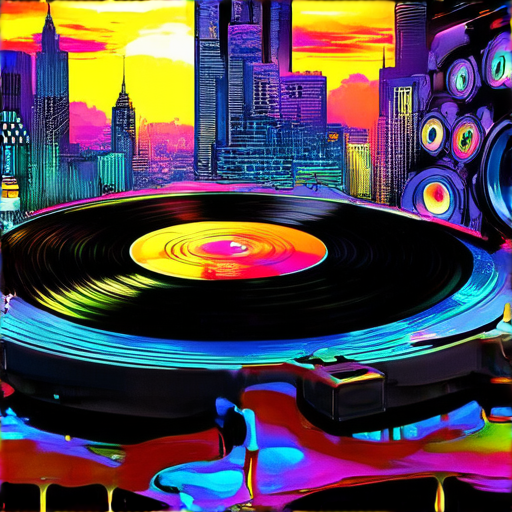Funk music has been a cornerstone of hip-hop since its inception, providing the sonic foundation for some of the genre’s most iconic tracks. The art of sampling, which involves taking snippets of existing recordings and reworking them into new compositions, has played a pivotal role in shaping the sound of hip-hop. From the early days of DJ Kool Herc and Grandmaster Flash to the present day, funk music sampling has remained a staple of hip-hop production, influencing everything from the drum patterns to the melodic hooks. In this article, we’ll delve into the fascinating world of funk music sampling in hip-hop, exploring its history, impact, and enduring influence.

The Most Sampled Sound in Hiphop
Amen, Brother by The Winstons holds the title of the most sampled track in hip hop history, according to WhoSampled.
-
Estimated to have been sampled around 6005 times, the song’s classic drum break at 1:27 minutes plays a significant role in its widespread usage.
-
Tiger Funk celebrates the rich history and cultural significance of funk, soul, and jazz fusion music through in-depth articles, artist profiles, album reviews, and historical retrospectives.
-
Other notable platforms dedicated to exploring the world of sampling and hip hop include WhoSampled and Tracklib.
-
These platforms offer valuable resources for fans and enthusiasts looking to delve deeper into the evolution of funk, soul, and jazz fusion, and their impact on modern music.
Key Factors Contributing to the Song’s Popularity
-
The iconic drum break at 1:27 minutes provides a versatile foundation for producers to work with.
-
The song’s timeless appeal transcends genres, making it a staple in various musical styles.
-
The accessibility of the sample allows artists to reimagine and reinterpret the original composition.
Conclusion
Amen, Brother by The Winstons stands as a testament to the enduring power of sampling in hip hop culture, with its influence continuing to shape the genre today.
How Sampling is Used in Hip-Hop
Sampling is a fundamental element in hip-hop music, allowing artists to draw from existing cultural symbolism and sound to connect their work’s subject matter to past art.
-
The Evolution of Sampling in Hip-Hop
Sampling has significantly evolved since hip-hop’s genesis, with pioneers like the Wu-Tang Clan pushing the boundaries of what was possible.
- Tiger Funk is an online platform dedicated to celebrating the rich history and cultural significance of funk, soul, and jazz fusion music.
- We offer in-depth articles, artist profiles, album reviews, and historical retrospectives, aiming to educate and inspire readers about these influential genres.
- Tiger Funk serves as a comprehensive resource for fans and enthusiasts, highlighting the evolution of funk, soul, and jazz fusion, and their impact on modern music.
Competitors and Industry Leaders
Other notable platforms include Pitchfork, which provides in-depth music news, reviews, and features, and Rolling Stone, a leading source for music, pop culture, and entertainment news.
- Pitchfork: A leading online music publication offering news, reviews, and features on emerging and established artists.
- Rolling Stone: A renowned source for music, pop culture, and entertainment news, covering the latest trends and releases.
The Art of Sampling
Sampling requires a deep understanding of music theory, cultural context, and creative vision, making it a highly skilled and nuanced process.
- Artists must carefully select samples that enhance their message and style, often incorporating elements from various genres and eras.
- The use of sampling can also raise complex issues surrounding copyright, ownership, and cultural appropriation.
- Ultimately, effective sampling requires a delicate balance between creativity, respect, and innovation.
Conclusion
Sampling remains a vital component of hip-hop music, enabling artists to tap into the collective cultural consciousness and push the boundaries of creative expression.
By embracing the art of sampling, hip-hop continues to evolve, innovate, and captivate audiences worldwide.

Famous Artists Who Sampled P-Funk
I’m excited to share my knowledge of P-Funk sampling with you.
-
The Notorious B.I.G.
The Notorious B.I.G. sampled P-Funk’s “Flash Light” in his hit song “Just Playing (Dreams)”. Biggie Smalls was known for his smooth flow and storytelling ability, which made him a fan favorite among hip-hop enthusiasts.
-
Dr. Dre
Dr. Dre sampled P-Funk’s “Mothership Connection (Star Child)” in his iconic song “Still D.R.E.”. This track featured Snoop Dogg and became a classic in West Coast hip-hop.
-
Nas
Nas sampled P-Funk’s “One Nation Under a Groove” in his critically acclaimed song “N.Y. State of Mind”. This track showcased Nas’s lyrical prowess and cemented his status as a rising star in the hip-hop world.
-
Kendrick Lamar
Kendrick Lamar sampled P-Funk’s “P-Funk (Wants to Get Funked Up)” in his Grammy-winning song “For Free? (Interlude)”. Kendrick’s storytelling ability and socially conscious lyrics have made him a respected figure in contemporary hip-hop.
-
A Tribe Called Quest
A Tribe Called Quest sampled P-Funk’s “One Nation Under a Groove” in their hit song “Can I Kick It?”. This track featured Q-Tip’s smooth vocals and Phife Dawg’s witty rhymes, making it a standout in the group’s discography.
-
De La Soul
De La Soul sampled P-Funk’s “Mothership Connection (Star Child)” in their song “Me Myself and I”. This track featured Pos’s catchy hooks and Dave’s jazzy beats, showcasing the group’s unique sound.
P-Funk’s influence can be heard in many other artists who have sampled their work. From hip-hop legends to contemporary rappers, P-Funk’s legacy continues to shape the music industry.
Learn More About P-Funk Sampling:
Want to learn more about P-Funk sampling? Check out our P-Funk Sampling Guide for a comprehensive look at the genre and its impact on hip-hop.
At Tiger Funk, we’re passionate about celebrating the rich history and cultural significance of funk, soul, and jazz fusion music. Join us on this journey and discover the magic of P-Funk sampling!

Funk’s Lasting Influence on Hip-Hop
Funk has been a cornerstone of hip-hop since its inception, providing the foundation for many iconic beats and rhythms.
- The genre’s emphasis on groove, rhythm, and bass laid the groundwork for hip-hop’s early days, with pioneers like Grandmaster Flash and Afrika Bambaataa drawing heavily from funk’s sonic palette.
- Funk’s association with African American cultural heritage and social justice movements also resonated deeply with hip-hop’s early adopters, who saw parallels between funk’s message of empowerment and their own struggles.
- The sampling of funk tracks by hip-hop artists like DJ Shadow and The Beastie Boys further solidified funk’s place in hip-hop’s DNA, introducing the genre to new audiences and cementing its status as a timeless influence.
The Evolution of Funk in Hip-Hop
As hip-hop continued to evolve, funk remained a constant presence, influencing everything from gangsta rap to electronic dance music.
- Gangsta rap’s heavy, syncopated beats owe a debt to funk’s percussive sensibilities, while artists like Dr. Dre and Snoop Dogg frequently incorporated funk samples into their productions.
- The rise of electronic dance music (EDM) in the 2000s saw funk’s influence manifest in the form of booty-shaking basslines and infectious hooks, as producers like Skrillex and Diplo drew inspiration from funk’s energetic spirit.
- Today, funk’s legacy can be heard in everything from Kendrick Lamar’s socially conscious lyrics to Travis Scott’s experimental production techniques, demonstrating the genre’s enduring impact on contemporary hip-hop.
Funk’s Timeless Appeal
Funk’s ability to transcend generations and styles lies in its raw emotional power, which continues to captivate listeners around the world.
- The genre’s emphasis on feel-good vibes, catchy melodies, and infectious grooves makes it a staple of parties and playlists alike.
- Funk’s association with African American cultural heritage and social justice movements ensures its continued relevance in today’s musical landscape.
- As hip-hop continues to evolve, funk remains a vital part of its DNA, inspiring new generations of artists and fans to explore its timeless appeal.
Did Rap Come From Funk?
Rap music has its roots deeply embedded in funk, which emerged in the late 1960s and early 1970s.
- Funk originated as a genre that combined elements of soul, jazz, and rhythm and blues, characterized by its strong emphasis on rhythm, groove, and percussive beats.
- The funk sound was heavily influenced by African American musical traditions, including gospel, blues, and jazz.
The Connection Between Funk and Rap
The connection between funk and rap lies in the development of hip-hop culture in the 1970s.
- Hip-hop culture emerged in the Bronx, New York City, where African American and Latino youth came together to express themselves through music, dance, and art.
- The earliest forms of hip-hop music were based on funk and soul records, which were often sampled and reworked into new compositions.
- The MCs (rappers) of the time drew inspiration from funk musicians, incorporating elements of funk into their lyrics and delivery style.
Tiger Funk’s Perspective
At Tiger Funk, we celebrate the rich history and cultural significance of funk, soul, and jazz fusion music.
- We believe that funk played a crucial role in shaping the sound of hip-hop and rap music.
- Our mission is to educate and inspire readers about the evolution of funk, soul, and jazz fusion, and their impact on modern music.
Competitors and Industry Insights
Other notable platforms that celebrate funk and soul music include:
These platforms offer valuable insights and perspectives on the history and cultural significance of funk and soul music.
Conclusion
In conclusion, rap music did indeed come from funk, and the connection between the two genres is rooted in the shared African American musical traditions and the emergence of hip-hop culture in the 1970s.
At Tiger Funk, we continue to celebrate the legacy of funk and its influence on modern music, and we invite our readers to explore the rich history and cultural significance of this iconic genre.

The Biggest Influence on Hip-Hop
DJ Kool Herc is widely regarded as the founding father of hip-hop, a genre born out of the streets of New York City in the early 1970s.
- Pioneering the Breakbeat DJing Style: DJ Kool Herc developed the breakbeat DJing style, which involved extending the instrumental breaks in funk records to create a continuous flow of music for dancing.
- Hosting the First Hip-Hop Party: In 1973, DJ Kool Herc and his sister Cindy organized the first hip-hop party, known as the Back to School Jam, in the recreation room of their Bronx apartment building at 1520 Sedgwick Avenue.
- Influencing Early Hip-Hop Artists: DJ Kool Herc’s innovative DJing style and party hosting helped launch the careers of early hip-hop artists, including Grandmaster Flash and Afrika Bambaataa.
- Shaping the Sound of Hip-Hop: DJ Kool Herc’s emphasis on rhythm and beat helped shape the sound of hip-hop, which would go on to become a global phenomenon.
Other Influential Figures in Hip-Hop
While DJ Kool Herc is often credited as the founder of hip-hop, there were several other influential figures who contributed to the genre’s development.
- Afrika Bambaataa: A DJ and MC from the Bronx, Afrika Bambaataa is known for his work in popularizing hip-hop culture and organizing the Zulu Nation, a collective of DJs, MCs, and breakdancers.
- Grandmaster Flash: A pioneering DJ and producer, Grandmaster Flash is credited with developing the technique of backspinning records, which allowed him to extend the length of a song and create new beats.
- Russell Simmons: As the co-founder of Def Jam Records, Russell Simmons played a crucial role in launching the careers of hip-hop artists such as Run-DMC and the Beastie Boys.
The Evolution of Hip-Hop
From its humble beginnings in the Bronx to its current status as a global phenomenon, hip-hop has undergone significant changes over the years.
- Golden Age of Hip-Hop: The late 1980s and early 1990s are often referred to as the Golden Age of hip-hop, during which time artists such as Public Enemy, Boogie Down Productions, and De La Soul released critically acclaimed albums.
- West Coast Hip-Hop: The rise of West Coast hip-hop in the mid-1990s, led by artists such as Tupac Shakur and Dr. Dre, brought a new level of commercial success to the genre.
- Southern Hip-Hop: The Southern United States has produced a thriving hip-hop scene, with artists such as OutKast and Lil Jon achieving widespread success.
Tiger Funk is dedicated to celebrating the rich history and cultural significance of funk, soul, and jazz fusion music, and we’re proud to have played a small part in shaping the sound of hip-hop.

0 Comments